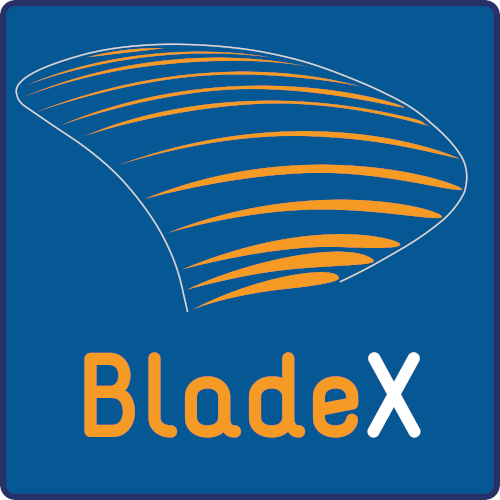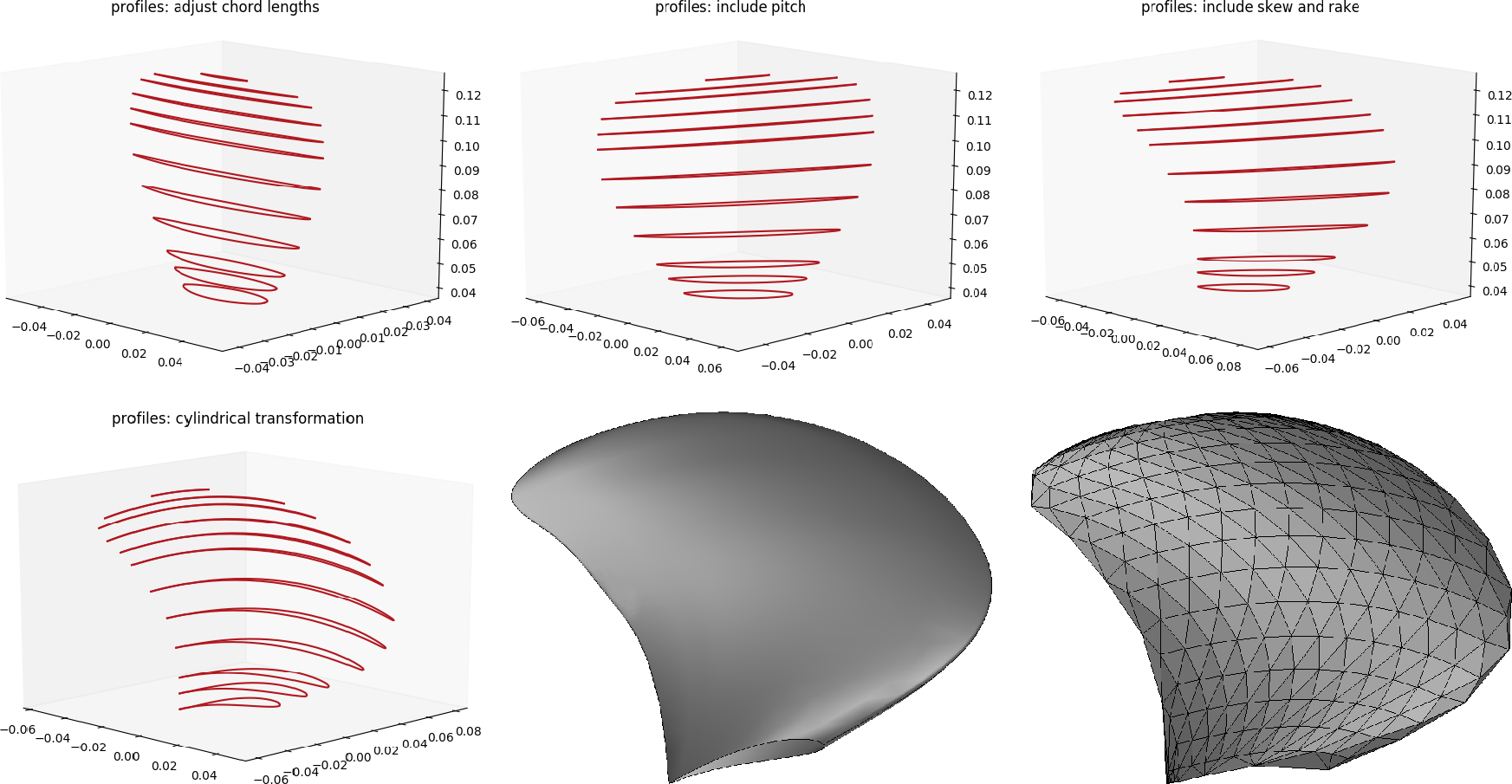mathLab / Bladex
Programming Languages
Labels
Projects that are alternatives of or similar to Bladex
BladeX (Python Blade Morphing) is a Python package for geometrical parametrization and bottom-up construction of propeller blades. It allows to generate and deform a blade based on the radial distribution of its parameters.
Table of contents
- Description
- Dependencies and installation
- Documentation
- Testing
- Examples
- How to cite
- Authors and contributors
- Support
- How to contribute
- SISSA mathLab packages for reduced order modeling
- License
Description
BladeX is a Python package for geometrical parametrization and bottom-up construction of propeller blades. It allows to generate and deform a blade based on the radial distribution of its parameters such as pitch, rake, skew, and the sectional foils' parameters such as chord and camber. The package is ideally suited for parametric simulations on large number of blade deformations. It provides an automated procedure for the CAD generation, hence reducing the time and effort required for modelling. The main scope of BladeX is to deal with propeller blades, however it can be flexible to be applied on further applications with analogous geometrical structures such as aircraft wings, turbomachinery, or wind turbine blades.
See the Examples section below and the Tutorials to have an idea of the potential of this package.
Dependencies and installation
BladeX requires numpy, scipy, matplotlib, sphinx (for the documentation), and nose (for the local test). They can be easily installed using pip.
BladeX is compatible with Python 2.7 and Python 3.6. Moreover, some of the modules require OCC to be installed for the .iges or .stl CAD generation. Please see the table below for instructions on how to satisfy the OCC requirements. You can also refer to pythonocc.org or github.com/tpaviot/pythonocc-core for further instructions.
| Package | Version | How to install (precompiled binaries via conda) |
|---|---|---|
| OCC | ==0.18.1 | Python2.7 conda install -c conda-forge -c dlr-sc -c pythonocc -c oce pythonocc-core==0.18.1 smesh=6.7.5 python=2.7
|
| OCC | ==0.18.1 | Python3.6 conda install -c conda-forge -c dlr-sc -c pythonocc -c oce pythonocc-core==0.18.1 smesh=6.7.5 python=3.6
|
Installing from source
The official distribution is on GitHub, and you can clone the repository using
> git clone https://github.com/mathLab/BladeX
To install the latest version of the package just type:
> pip install git+https://github.com/mathLab/BladeX.git
Otherwise to install your own local branch you can use the setup.py file
> python setup.py install
To uninstall the package just use pip again:
> pip uninstall bladex
Documentation
BladeX uses Sphinx for code documentation. You can view the documentation online here. To build the html version of the docs locally simply:
> cd docs
> make html
The generated html can be found in docs/build/html. Open up the index.html you find there to browse.
Testing
We are using Travis CI for continuous intergration testing. You can check out the current status here.
To run tests locally:
> python test.py
Examples
You can find useful tutorials on how to use the package in the tutorials folder.
Here we show a bottom-up parametrized construction of the Potsdam Propeller Test Case (PPTC) provided the sectional profiles as well as the radial distribution of the pitch, rake, skew. The blade is generated and exported to .iges and .stl formats.
PPTC blade generation according to the radial distribution of the pitch, rake, skew. The generated blade is then exported to .iges and .stl formats.
Two possible deformed geometry configurations, to show the capabilities of the package, are presented here:
Undeformed reference blade on the left, and a couple of deformed configurations obtained by moving some control points defining the skew and chord length radial distributions.
How to cite
If you use this package in your publications please cite the package as follows:
Gadalla et al., (2019). BladeX: Python Blade Morphing. Journal of Open Source Software, 4(34), 1203, https://doi.org/10.21105/joss.01203
Or if you use LaTeX:
@article{gadalla19bladex,
Author = {Gadalla, Mahmoud and Tezzele, Marco and Mola, Andrea and Rozza, Gianluigi},
Title = {{BladeX: Python Blade Morphing}},
Journal = {The Journal of Open Source Software},
Volume = {4},
Number = {34},
Pages = {1203},
Year = {2019},
Doi = {https://doi.org/10.21105/joss.01203}
}
Recent works with BladeX
Here there is a list of the scientific works involving BladeX you can consult and/or cite. If you want to add one, please open a PR.
-
Mola, Tezzele, Gadalla, Valdenazzi, Grassi, Padovan, Rozza. Efficient reduction in shape parameter space dimension for ship propeller blade design. In Proceedings of MARINE 2019: VIII International Conference on Computational Methods in Marine Engineering, pages 201–212, 2019. [DOI] [arXiv] [bibitem].
-
Tezzele, Demo, Mola, Rozza. An integrated data-driven computational pipeline with model order reduction for industrial and applied mathematics. Submitted, 2018. [arXiv] [bibitem].
Authors and contributors
BladeX is currently developed and mantained at SISSA mathLab by
under the supervision of Dr. Andrea Mola and Prof. Gianluigi Rozza in the framework of the project PRELICA: Advanced Methodologies for Hydro-acoustic Design of Naval Propulsion.
Support
Contact us by email for further information or questions about BladeX. Feel free to suggest pull requests or to open GitHub issues. Contributions improving either the code or the documentation are welcome!
How to contribute
We'd love to accept your patches and contributions to this project. There are just a few small guidelines you need to follow.
Submitting a patch
-
It's generally best to start by opening a new issue describing the bug or feature you're intending to fix. Even if you think it's relatively minor, it's helpful to know what people are working on. Mention in the initial issue that you are planning to work on that bug or feature so that it can be assigned to you.
-
Follow the normal process of forking the project, and setup a new branch to work in. It's important that each group of changes be done in separate branches in order to ensure that a pull request only includes the commits related to that bug or feature.
-
To ensure properly formatted code, please make sure to use 4 spaces to indent the code. The easy way is to run on your bash the provided script: ./code_formatter.sh. You should also run pylint over your code. It's not strictly necessary that your code be completely "lint-free", but this will help you find common style issues.
-
Any significant changes should almost always be accompanied by tests. The project already has good test coverage, so look at some of the existing tests if you're unsure how to go about it. We're using coveralls that is an invaluable tools for seeing which parts of your code aren't being exercised by your tests.
-
Do your best to have well-formed commit messages for each change. This provides consistency throughout the project, and ensures that commit messages are able to be formatted properly by various git tools.
-
Finally, push the commits to your fork and submit a pull request. Please, remember to rebase properly in order to maintain a clean, linear git history.
SISSA mathLab packages for reduced order modeling
Below you can find a list of useful reduced order modelling packages from SISSA mathLab group:
- PyGeM: Python library for Geometrical Morphing, that uses free form deformation to parametrize and morph complex geometries, https://github.com/mathLab/PyGeM.
- PyDMD: Python library for Dynamic Mode Decomposition, for a data-driven model simplification based on spatiotemporal coherent structures, https://github.com/mathLab/PyDMD.
- RBniCS: reduced order modelling in FEniCS, is an implementation in FEniCS of several reduced order modelling techniques for parametrized problems, https://github.com/mathLab/RBniCS.
- EZyRB: Easy Reduced Basis method, is a python library for the Model Order Reduction based on baricentric triangulation for the selection of the parameter points and on Proper Orthogonal Decomposition for the selection of the modes, https://github.com/mathLab/EZyRB.
- ITHACA-FV: In real Time Highly Advanced Computational Applications for Finite Volumes, is C++ library based on the finite volume solver OpenFOAM. It consists of the implementation of several reduced order modeling techniques for parametrized problems, https://github.com/mathLab/ITHACA-FV.
- ITHACA-DG: In real Time Highly Advanced Computational Applications for Discontinuous Galerkin Methods, is C++ library based on the Discontinuous Galerkin Methods solver HopeFOAM. It consists of the implementation of reduced order modeling techniques for parametrized problems, https://github.com/mathLab/ITHACA-DG.
- ITHACA-SEM: In real Time Highly Advanced Computational Applications for Spectral Element Methods, is C++ library based on the spectral element solver Nektar++. It consists of the implementation of several reduced order modeling techniques for parametrized problems, https://github.com/mathLab/ITHACA-SEM.
License
See the LICENSE file for license rights and limitations (MIT).




